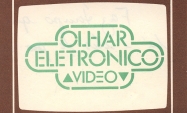
One of Brazil’s two leading video production companies of the 1980s, Olhar Eletrônico played a key-role in consolidating Brazilian video art, alongside the TVDO group. The former was characterized by strong inventive interaction with open television programming, while the second adopted a more experimental stance, although it entertained ambitions of intervening on mass media vehicles. Comprised of newly graduated students from the School of Architecture of the University of São Paulo, the company started working in 1981, initially composed by Fernando Meirelles, Marcelo Machado, Paulo Morelli and Beto Salatini. Soon Dario Vizeu, Marcelo Tas, Renato Barbieri and Toniko Melo joined them. The company was headquartered at a house on Benedito Calixto Square. From 1983 to 1987 they created several programs for TV channels Gazeta, Manchete, Cultura, Globo and Abril Vídeo. Highlight works include Garotos do Subúrbio, Brasília, Eletroagentes, S.A.M. Varela no Congresso, Ali Babá, Do outro lado da sua casa and Tragédia SP. Marly Normal, from 1983, may be one of considered the Brazilian predecessors of the music video, with fast-changing close-ups that show 24 hours of a character’s life over the course of 6 minutes. The show Crig Rá, made in 1984 for Abril Vídeo, featured various personalities, such as Giulia Gam, Paulo Cesarino Costa, Adriano Goldman, José Roberto Sadek, Sandra Annemberg, among others. In 1987, the group produced O Mundo no Ar, a TV news parody program showing how information can be manipulated. The group gradually dispersed in the late 1980s.